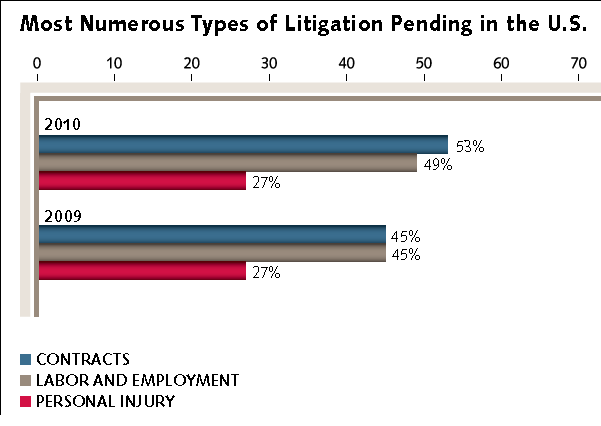Fulbright Report Sees Upswing in Litigation
.jpg) A new survey of 400 corporate counsel by Fulbright & Jaworski finds that regulatory litigation, suits by bigger companies, and industries like real estate, manufacturing, energy and health care will drive new growth in litigation.
A new survey of 400 corporate counsel by Fulbright & Jaworski finds that regulatory litigation, suits by bigger companies, and industries like real estate, manufacturing, energy and health care will drive new growth in litigation.
Roughly one-quarter of in-house counsel say legal disputes will increase again, according to the 2010 Fulbright & Jaworski L.L.P. Litigation Trends Survey.
For all the details visit the LawMarketing Portal at http://bit.ly/czHimj It's a 28-page illustrated report, and here are the highlights:
- Social technology and online business strategies are another area of potential e-discovery problems since some businesses have been early adopters of social media functionality, not for their employees’ personal use but for business uses, such as recruiting (LinkedIn) and marketing (FaceBook). Fulbright asked respondents how they are using social networking for business purposes.
- More than one-quarter of corporate counsel now say their company uses LinkedIn, while 22% of respondents use Twitter and 17% use Facebook.
- Nearly one-quarter of all respondents say their company uses some kind of corporate blog.
- Regulatory investigations have nearly doubled, particularly in the banking, health care, energy and insurance industries. The agencies that will keep defense lawyers billing time are the DOJ, SEC, EPA, FDA and OSHA.
- After reporting declining litigation filings in 2006 and 2007, respondents say suits began to rise again in 2008 and 2009. The upward trend continued in 2010.
- In last year’s survey, 42% of U.S. respondents expected legal disputes to increase. That prediction came true: 87% of U.S. respondents faced at least one lawsuit, arbitration, or regulatory proceeding last year.
- Industries that saw the most litigation were real estate (88%), manufacturing (86%), energy (86%) and health care (83%) took on the most new lawsuits, while manufacturing was hammered with the most big dollar lawsuits. A hefty 43% of manufacturing respondents saw at least one $20 million-plus suit over the past year.
- Internal investigations requiring outside counsel are dramatically up across the board this year. This year, 43% of respondents said they initiated an internal investigation requiring the assistance of outside counsel, compared to just 28% of respondents who reported the same last year.
- Whistleblower allegations remain high, with 1/5 of all respondents have been subjected to whistleblower allegations in the past three years.
- Recent interest by the SEC and DOJ in cracking down on foreign corruption has led to a jump in FCPA matters. One-quarter of both large-cap respondents and public company respondents have engaged outside counsel in the past 12 months to assist with a bribery or corruption investigation – up from 17% in last year’s survey.
- Across the board, employment litigation is up. Much of the litigation swell was due to spikes in labor and employment suits. For the third straight year, sizeable portions of survey respondents report increases in multi-plaintiff cases:
- 18% report increases in wage and hour disputes (FLSA)
- 11% report a rise in traditional labor union related matters
- 10% report an increase in age discrimination cases
- 7% report rises in race discrimination suits and ERISA suits
- 6% report rises in sex discrimination suits and disability discrimination suits.
- 28% of corporations increased their litigation budget, and 31% increased their actual litigation spending.
- Companies hire outside lawyers for "specific expertise," "broader jurisdiction" and "more litigation."
- Fulbright found that a majority, 51%, of all respondents used some kind of alternative fee arrangement. However, 60% predict the use of alternative fees will not increase in the coming year.




